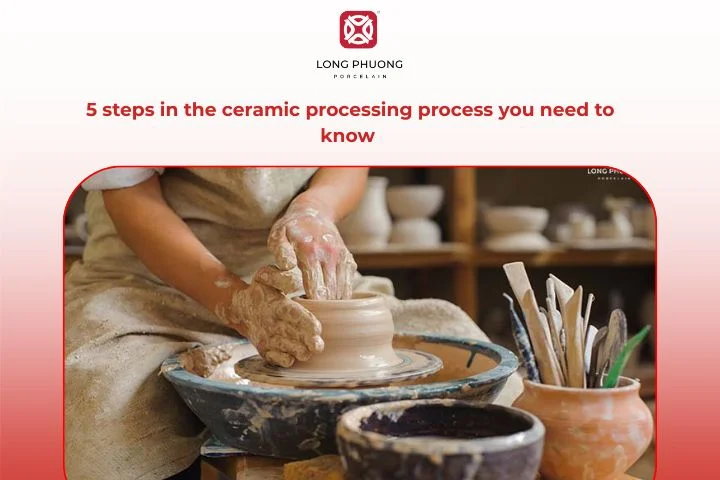Ceramics have been part of human life for thousands of years, from functional tableware to intricate decorative items. Understanding ceramic processing can help you appreciate the artistry and science behind every porcelain plate or bowl. In this article, Long Phuong will explore the ceramic coating process, the processing of ceramic materials, and the essential stages that transform raw clay into beautiful, durable ceramics through advanced ceramic processing techniques.

1. What is the processing of ceramics?
Ceramic processing is a multi-step manufacturing method used to manufacture ceramic materials and products. It starts with raw ingredients and ends with a finished, usable item. This process is crucial because it determines the final properties of the ceramic, such as its strength, durability, and appearance.

From simple pottery to high-tech industrial parts, the principles of ceramic processing apply universally. By mastering the steps of ceramic processing, artisans and manufacturers alike ensure that each piece meets both functional and aesthetic standards.
2. What are the five stages of ceramics? Everything you need to know.
Creating ceramics involves several carefully controlled stages. Let’s break down the five stages of ceramic processing.
2.1. Stage 1: Raw material preparation

The journey begins with the earth itself. The primary raw materials for ceramics are natural clays like kaolin, feldspar, and silica. This first stage involves preparing these raw ingredients.
- Sourcing and Cleaning: Raw materials are mined and then cleaned to remove impurities.
- Mixing and Blending: Different materials are carefully mixed in specific ratios to achieve the desired composition. This is a crucial step that affects the final product’s quality and properties. For example, a precise blend is needed for our Long Phuong dinnerware sets to ensure they are both beautiful and long-lasting.
- Milling: The mixture is often ground into a fine powder to ensure uniform particle size and consistency.
2.2. Stage 2: Shaping/Forming

Once the raw materials are prepared, they are formed into the desired shape. This is where a shapeless lump of material begins to resemble a finished product. There are several common methods for this stage:
- Slip Casting: A liquid clay mixture (slip) is poured into a mold, which absorbs the water, leaving a solid layer. This is perfect for creating intricate shapes like our Long Phuong vases.
- Extrusion: A stiff clay mixture is pushed through a die to create long, uniform shapes like pipes or rods.
- Pressing: Powdered clay is pressed into a mold under high pressure. This method is used for making tiles and other flat products.
- Jiggering/Jollying: A technique used for plates and bowls, where a tool forms one side of the piece while a rotating mold forms the other.
2.3. Stage 3: Drying

After shaping, the ceramic piece is still fragile and contains a significant amount of water. The drying stage is critical to remove this moisture slowly and evenly.
- Purpose: Rapid drying can cause warping, cracking, or breaking. Slow, controlled drying allows the piece to shrink uniformly as water evaporates.
- Process: The formed ceramic items are placed in a controlled environment with specific temperature and humidity levels. Once dry, the piece is known as “greenware” – it is extremely fragile and ready for the next step.
2.4. Stage 4: Firing/Sintering

Firing, also known as sintering, transforms the dried piece into a solid, durable material. The ceramics are heated at high temperatures, often between 800°C and 1400°C, depending on the material. The ceramic coating process may be applied at this stage to enhance strength, prevent absorption, or add decorative finishes.
2.5. Stage 5: Finishing/Glazing

The final step is to apply a finish or a ceramic coating process to the product.
- Glazing: Glazes are glass-like coatings that are applied to the fired ceramic. They serve several purposes:
- Other Finishes: Some ceramics may undergo other finishing steps like polishing or sanding to achieve a desired texture.
3. Applications of ceramic processing
While the five steps of ceramic processing are a universal guide, the specific raw materials and techniques are what define the final product. At Long Phuong, we specialize in high-quality porcelain, which is a type of ceramic. Unlike general ceramics, porcelain uses a specific, refined blend of clay, primarily kaolin, and is fired at much higher temperatures. This meticulous approach results in a superior product with a smooth, translucent finish and exceptional durability.

The entire process, from preparing our unique clay mixture to our signature ceramic coating process, is precisely controlled to produce dinnerware that is not only stunningly beautiful but also incredibly strong. This is why our porcelain products are resistant to chipping and scratching, making them the perfect choice for everyday use in homes and professional settings.
By applying the knowledge of ceramic processing to porcelain, we deliver items that are both functional and artistic. Explore Long Phuong Porcelain’s collection today to enjoy the elegance and durability of expertly crafted porcelain.
See more: What is porcelain? The difference between ceramic and porcelain?
4. FAQ

4.1. What is the process of making ceramics called?
The overall process of making ceramics is commonly referred to as “ceramic processing” or simply “ceramics.”
4.2. What are 5 products made from ceramics?
Some common products include:
- Dinnerware (plates, bowls)
- Tiles and bricks
- Porcelain figurines
- Industrial ceramics (insulators, furnace components)
- Sanitary ware (sinks, toilets)
4.3. How to make ceramics at home without a kiln?
You can use air-dry clay or polymer clay. While these materials won’t achieve the durability of kiln-fired ceramics, they are perfect for crafts, decorations, and small functional items.
4.4. What are the raw materials of ceramics?
The main raw materials are natural clays like kaolin, feldspar, and silica. Other additives like alumina or zircon may be used for specific properties.
4.5. What equipment is necessary for creating ceramic?
For basic ceramics, you’ll need a potter’s wheel for shaping, various sculpting tools, and a kiln for firing. For commercial production, industrial mixers, kilns, and specialized molding equipment are necessary.
5. Bottom line
Understanding the ceramic processing stages helps you appreciate the skill and science behind every piece of porcelain. From raw material preparation to glazing, each step contributes to the durability, functionality, and beauty of the final product. For those seeking high-quality, elegantly crafted dinnerware, Long Phuong Porcelain offers an exceptional range that combines traditional craftsmanship with modern ceramic technology.
Long Phuong Group Joint Stock Company
- Phone number: (+84) 989 595 866
- Email: export@longphuong.vn
- Factory: Hap Linh Industrial Cluster, Hap Linh, Bac Ninh, Vietnam
- Showroom Ha Noi: 59 Cua Bac, Ba Dinh Ward, Hanoi, Vietnam
- Showroom Ha Noi: 37 Cua Nam, Cua Nam Ward, Hanoi, Vietnam
- Showroom TP. Ho Chi Minh: 127 Le Thi Rieng, Ben Thanh Ward, Ho Chi Minh, Vietnam
CEO of Long Phuong Group Joint Stock Company, with more than 20 years of exploration and research to obtain the best formulas and professional experience, Long Phuong Porcelain has produced more than 400 designs of all kinds of household porcelain, Significant contributions to Vietnam's ceramic industry.
 Vietnam
Vietnam
